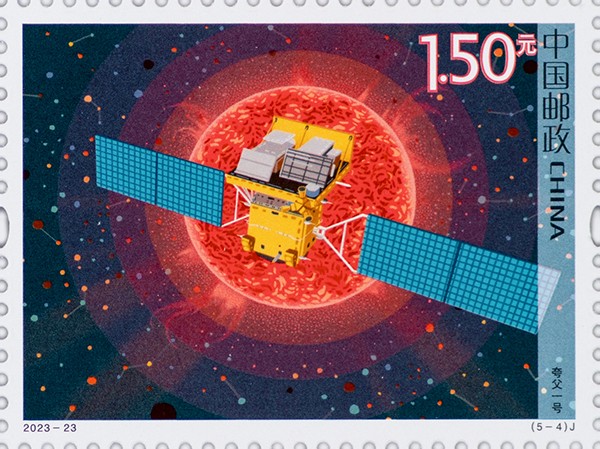Postal Business: 8610 11185
Postal Savings: 8610 95580
Logistics and EMS: 8610 11183
China Post Life: 8610 4008909999
 |
|
The fourth commemorative stamp: Kuafu-1 |
A set of five commemorative stamps Innovations in Science and Technology (Series 4) was issued on November 1, 2023, the designs of which feature the synthetic starch, the perennial rice, the Mars rover Zhurong, the Advanced Space-based Solar Observatory Kuafu-1 and the Large High Altitude Air Shower Observatory (LHAASO). The denomination of the whole set is 6.6 yuan, and 7 million sets are planned to be issued.
Designed by Du Yukai, this set of stamps follows the same characteristics of the previous three series: these stamps are also created in modern illustration methods, with bright and lively colors to present fresh and natural visuals. The stamps are printed by Beijing Stamp Printing House Company Limited with offset printing technology, and special colorless fluorescent ink is applied to display richer information of the stamps under ultraviolet light.
The stamps showcase China’s five innovation achievements in science and technology. Researchers of Tianjin Institute of Industrial Biotechnology of Chinese Academy of Sciences have made a significant breakthrough in the starch synthesis, a de novo route for artificial synthesis of starch from carbon dioxide without plant photosynthesis for the first time in the world. Perennial rice is an innovation in rice breeding. Without reseeding, this new rice variety can be harvested twice a year or for several years after overwintering, which can greatly reduce labor input, maintain relatively stable yields, and achieve light and simplified rice production. The Mars rover Zhurong is the world’s first Mars rover with an active suspension system. It can not only withstand the complex environment of Mars, but also conduct scientific exploration, deepening people’s knowledge of key scientific issues such as the evolution of Mars and its water/ice distribution. Kuafu-1 is an advanced solar exploration satellite independently proposed by Chinese solar physicists. It has achieved a leapfrog breakthrough in the space-based solar exploration satellite and opened up a new era of comprehensive space-based solar observation. The Large High Altitude Air Shower Observatory (LHAASO), also independently proposed, designed and constructed by Chinese scientists, is the new generation gamma ray telescopes and cosmic ray detectors with the unprecedented sensitivity. LHAASO is dedicated to decoding the origin of cosmic rays and hence more mysteries of the universe.






